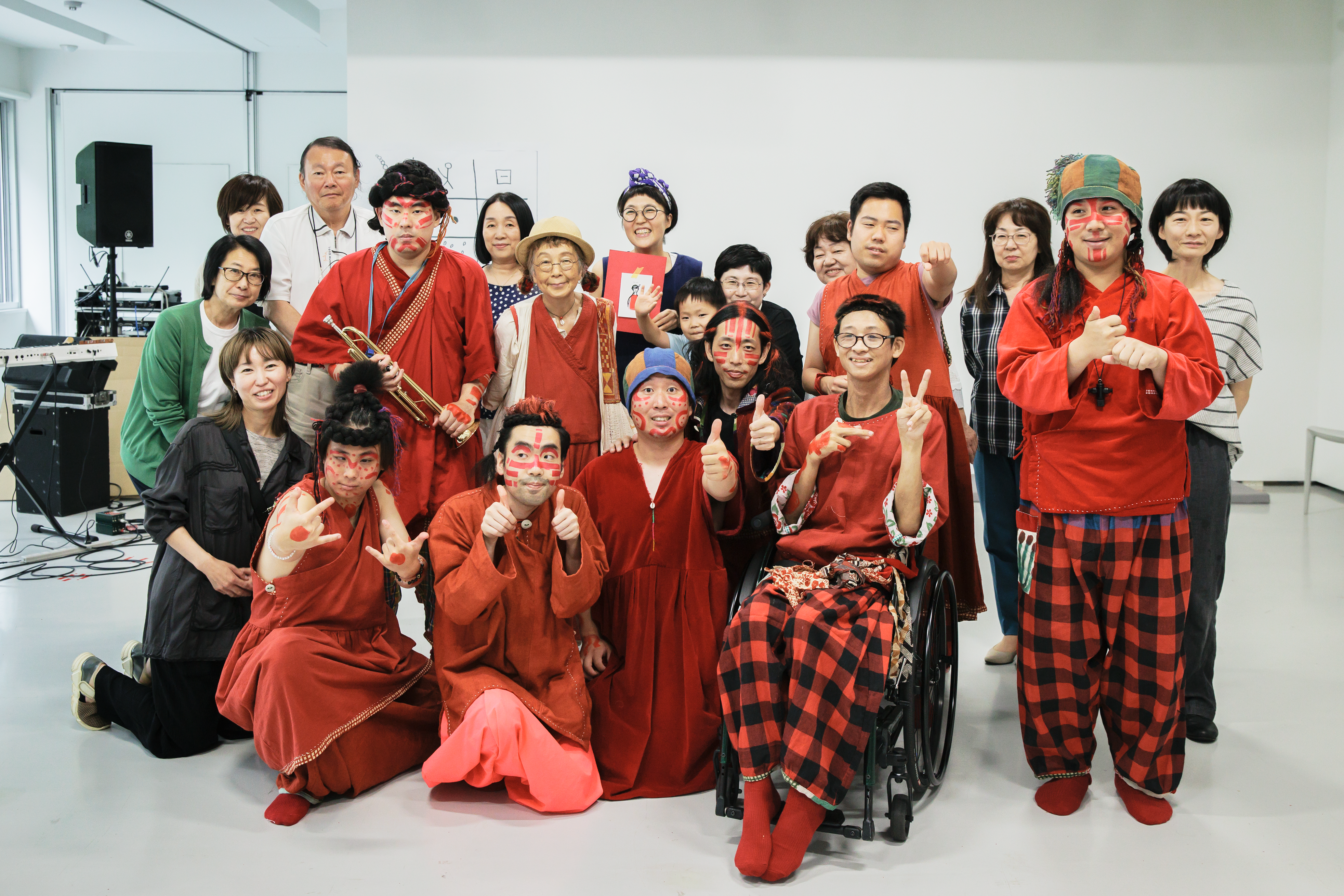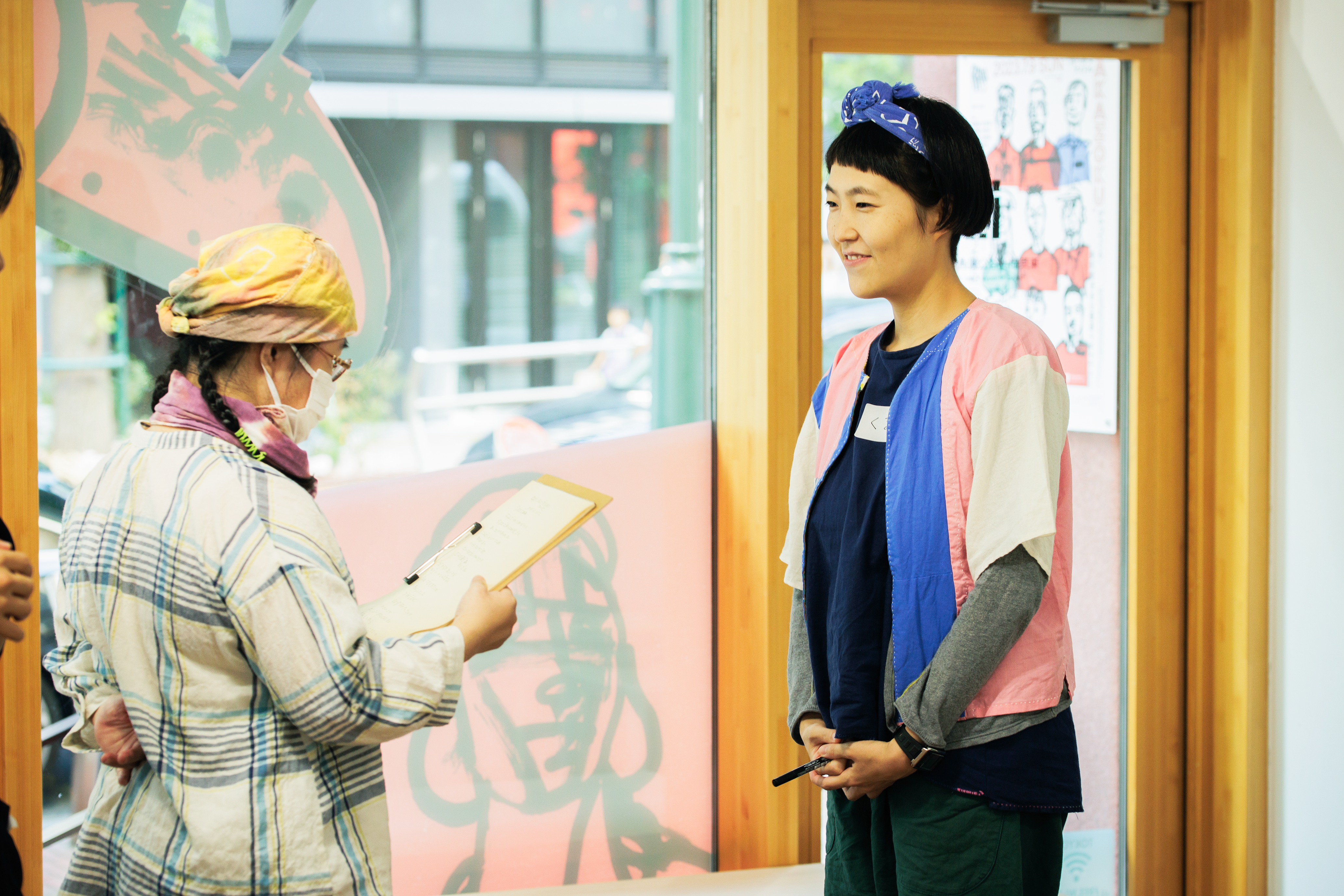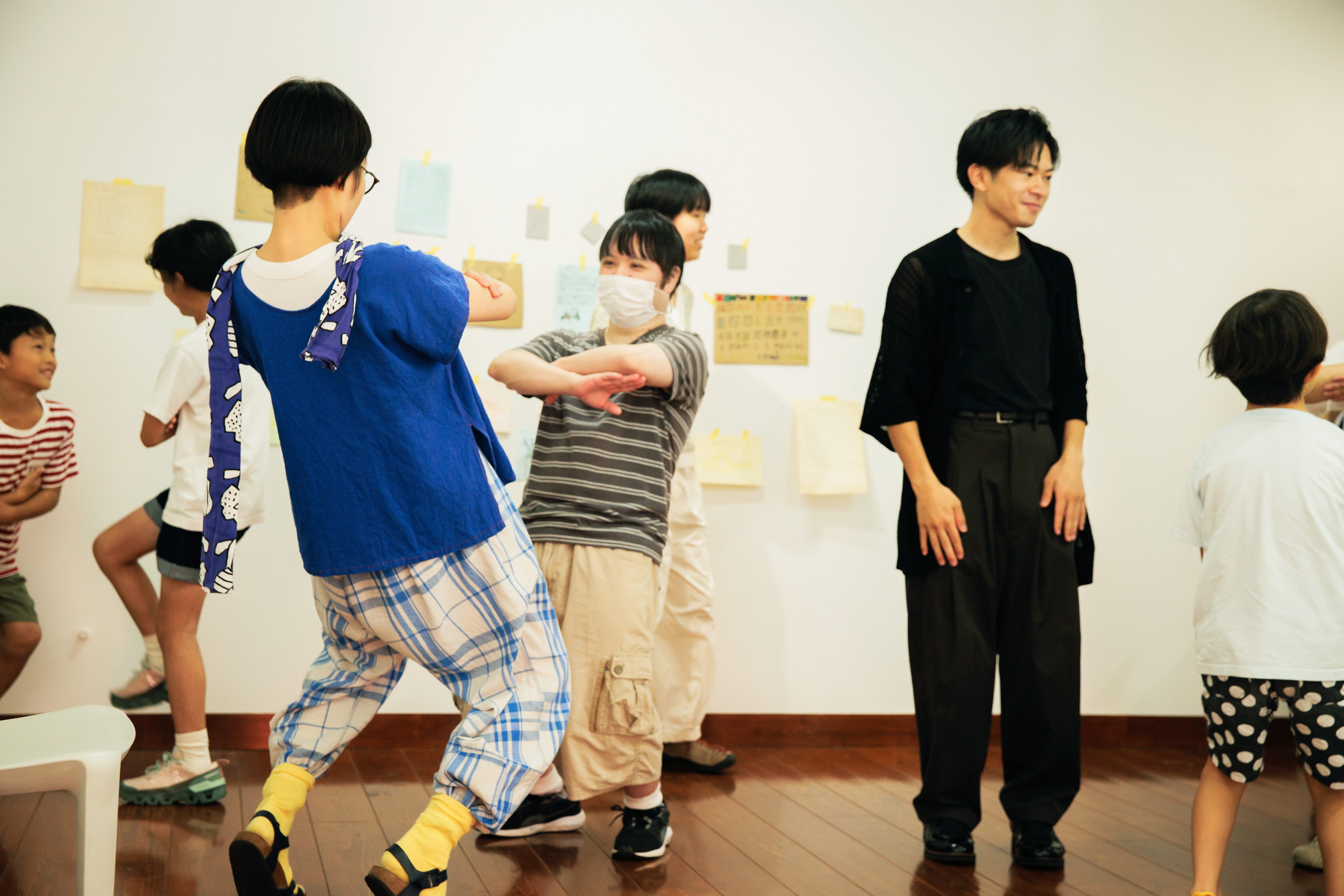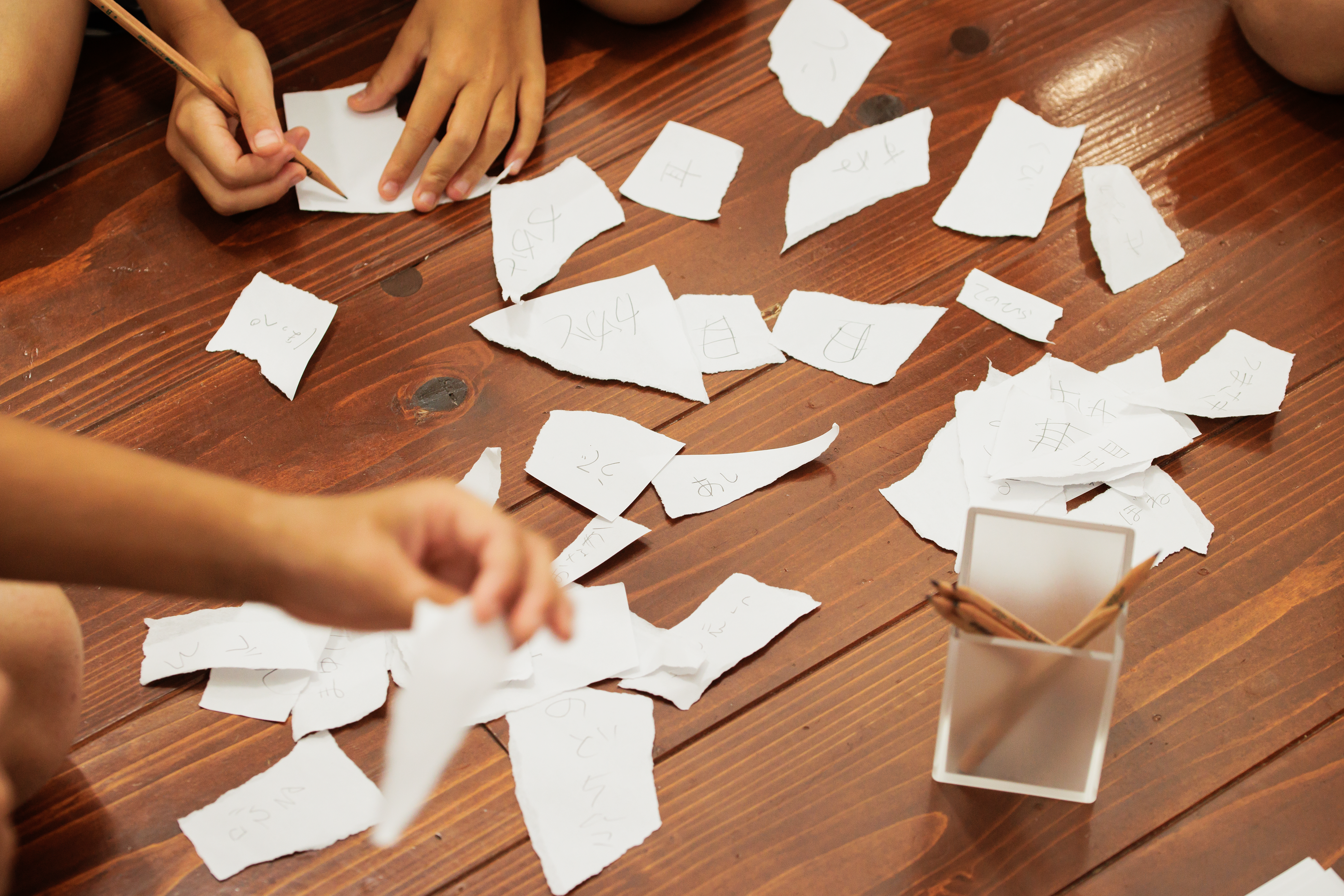Aiming to realize an inclusive, symbiotic society where people with diverse attributes can live in understanding with each other, the Tokyo Shibuya Koen-dori Gallery is implementing various projects that create opportunities for people to notice and contemplate things through art. In addition to exhibiting art brut works, the gallery offers a wide variety of interactive programs, including talks, concerts, performances, workshops, and other events that bring visitors into contact with diverse forms of creativity and new values.
![]()
![]()
事務局からのお知らせ
Report on Two Programs Held at the Tokyo Shibuya Koen-dori Gallery in Summer 2023: “Here Come ‘the AKAZOKU’ Red Idols” and “A Love Letter Every Time You Meet”

In the summer of 2023, the Tokyo Shibuya Koen-dori Gallery hosted two interactive programs with Kanazawa-based dance artist Kurumi Nakamura and “the Ala oruz,” a dance company directed by Nakamura which is composed of about 20 members with intellectual or physical disabilities.
“Idols” who express themselves in their own ways through music and dance
Performance Series “RAW” is an interactive program at the Tokyo Shibuya Koen-dori Gallery that provides a forum for showcasing forms of “raw expression” such as music, dance, and theater, which are difficult to adapt to an exhibition format. During the program, performers incorporate feedback from each other and the audience into their performance. The third iteration of this series was titled “Here Come ‘the AKAZOKU’ Red Idols.”
The performers were a special unit formed just for this event, consisting of four dancers from Ala oruz and two members of The Otoasobi Project, a Kobe-based group of musicians which, like Ala oruz, includes members with intellectual disabilities. They were joined by musician Yuhi Taka and video director Ryo Noda.
Acting as a facilitator was dance artist Kurumi Nakamura, who helped to enliven their performances by drawing out the performers’ expressiveness and charm. Based in Kanazawa, Nakamura has been using physical expression (dance) as a communication tool to convey the possibilities of the human body. She has held workshops and performances at the 21st Century Museum of Contemporary Art, Kanazawa, and other art museums, welfare facilities, and special-needs schools in Japan and abroad.

Upon entering the event space, audience members were given a “pictorial map” mounted on a bright red paper backing. According to Nakamura, “It’s like a map or menu for the performers and audience members to share what they are doing.” The same pictorial map that was distributed to the audience was also displayed on the wall in the event space.

The performance began with the upper left image on the “pictorial map.” The AKAZOKU are men dressed in ethnic red clothing with red face and body paint, who call themselves “red idols.” Eight AKAZOKU members, one of whom uses a wheelchair, were dressed in bright red costumes, each with a slightly different design, created by fabric artist Yumi Hayakawa. With video director Noda in the lead, the members first circled the entire space in a single file line. Watching the performance, the audience gradually began to realize that the first image on the pictorial map, which initially looked like a hieroglyph, was meant to represent people in a line and a camera.

After a while, Nakamura asked the members, “Should we play music and dance now?” This was the sign to start the scene depicted in the image that looks like scattered grains of rice. As The Otoasobi Project members Yoshimi-kun (Masaharu Yoshimi) and Takayama-kun (Masahiro Takayama) plucked the guitar and created a rhythm on the tambourine, the Ala oruz dancers Yoshibo (Yoshiki Hayashi), Rintaro-kun (Rintaro Uo), Kosei-kun (Kosei Oie), and Yacchan (Yasuaki Asanaga) scattered throughout the space, as depicted in the image, and began to strike poses. Supporting musician Yuhi-kun (Yuhi Taka) added improvised percussion sounds on the keyboard to liven up the guitar part. The dancers began to dance to this upbeat music, finding their own unique groove.

This was followed by a wide variety of performances based on images in the “pictorial map,” including an impromptu performance in which the four dancers took turns freely moving their bodies in front of the camera using props such as cardboard and a long string with pom-poms attached to both ends, a “conductor” performance in which musicians improvised music to match the movements of a performer playing the role of a conductor, and a section in which Yoshibo interviewed the members of the audience with a microphone.

Before each scene, Nakamura always asked the members, “Do we want to do it? What do we want to do?” This dialogue encouraged the members to express their desires without putting undue pressure on them. The AKAZOKU idols all dance or play instruments in diverse ways. By freely expressing themselves however they know best using the slightly unusual “pictorial map” as a guide, each individual’s personality was able to shine through. A unique performance unfolded, touching the hearts of the audience.
For the finale, Nakamura invited the audience to become a part of the performance. The program ended with the audience experiencing a sense of unity as they not only watched, but also participated in the performance through activities such as linking colorful strips of cloth distributed by the members to form a large circle.

The program was held twice, once in the morning and once in the afternoon, with sign language interpretation by Ichiro Hashimoto and live narration by Yuka Funamoto in the afternoon. It was moving to see deaf individuals and people with visual impairments all equally enjoying the event.
Video recordings of the performances (with audio captioning in Japanese) are available here: https://inclusion-art.jp/archive/interactive/2023/20230709-179.html
Expressing encounters with unique instructors through language and movement
“A Love Letter Every Time You Meet,” a two-day workshop for children, was held on Saturday, August 5, and Sunday, August 6. Three members from the Ala oruz who were not a part of the AKAZOKU participated in this program. They became instructors and enjoyed communicating with the children using their unique talents.
On day one, the first instructor to appear was Tamapi. Tamapi’s talent is making a variety of crafts with flyers. He cut flyers into strips and rolled them up into thin tubes, folded flyers into boxes, and finished all of his projects beautifully and silently at an astonishing speed. The children watched his movements carefully and tried to do the same things. Tamapi also assisted the children while watching over their work. Although few words were exchanged between them, it seemed that a “master-disciple” relationship was steadily developing between Tamapi and the children.

The next instructor was Taka-chan. Taka-chan loves showing the contents of his bag to other people. “He shows it to me even when I don’t ask for it,” says Nakamura, laughing. “But when we look at what he has in his bag, we can learn about what kind of things he likes and enjoys without him having to talk.” Therefore, everyone decided to show each other the contents of their bags. Taka-chan’s bag was filled with unique items such as a CD by enka singer Hiroshi Itsuki, a flyer for the zoo, a pair of sunglasses, TV Guide magazines, and a spoon.

The children were then asked to show off the contents of their bags. They had things such as erasers, plush toys, an insect picture book, water bottles, and commuter pass cases. Each person’s possessions were completely different from each other. Even if they had just met each other for the first time, they gradually came to know what kind of person each person was just by looking at their belongings.

The third and final instructor was Mori-san. Mori-san’s skill is conveying her feelings by writing letters almost every day to the people she loves. On this day, Mori-san was writing a letter to Nakamura-san, her favorite person. The children, like Mori-san, wrote letters to express their feelings of affection. Besides people, their letters were addressed to all kinds of recipients, including a cat and soccer. Some children communicated using pictures and colors, as well as text.


The three instructors communicated in unusual ways: folding flyers and making crafts, showing the contents of their bag, and writing letters. Despite being somewhat bewildered by these first encounters, the children spent time with each of the instructors, moving their hands and arranging words together, using this time to face and experience the new and unfamiliar.
On the second day, participants used their entire body to express what they experienced and felt the previous day. The first half of the session was time to reflect on what happened yesterday and think about ideas for creating a dance. First, the participants introduced themselves. Instead of simply talking about themselves, each participant stated his or her name along with a unique, improvised body movement, which was then imitated by everyone else.

Then, while walking around the room, they tagged people they passed with their hands and hips, exchanged original greetings, and selected pieces of paper with body parts written on them, posing to show off that part of their body. As their bodies loosened up and moved more freely, their movements gradually became larger.

In the second half of the session, participants expressed what they experienced and felt during the previous day’s workshop by dancing to original music that had been created especially for this day, using the movements and choreography they had been exploring so far. They moved their bodies however they liked, producing choreography based on the “rolling” movement from Tamapi’s workshop where he made cylinders out of rolled-up flyers, or the image of the spoon and sunglasses from Taka-chan’s bag, or the love letters they had written in Mori-san’s workshop.
This two-day program was an opportunity for participants to confront things they did not understand and were experiencing for the first time, and to express themselves first in words, and then with their bodies. The workshop ended with the hope that by encountering the unique forms of expression shared by the instructors, the children would be inspired to express themselves more freely and value what they love.
A vivid time spent enjoying improvisation and feedback from the audience and participants
Up until now, Kurumi Nakamura has conducted various performances and workshops with children, the elderly, and people with intellectual and physical disabilities. Normally active in Kanazawa, this was the first time for Nakamura and Ala oruz to hold performances and workshops at the Tokyo Shibuya Koen-dori Gallery.

Nakamura: “I was very interested in how I could show and present what I have done so far to the community by packaging my work in two different ways, as exemplified by these workshops. I was beyond excited to have such gentle and peaceful moments taking place in a corner of Shibuya, a city with so many people. It was inspiring, even.”
In “Here Come ‘the AKAZOKU’ Red Idols,” Nakamura approached the performers cheerfully and naturally, engaging in on-the-spot dialogue to draw out their expressivity. In the “A Love Letter Every Time You Meet,” she conducted the program in a flexible manner, watching the participating children and immediately incorporating their reactions into the program, as if enjoying the chemistry of the space without being bound by any formalities or rules.
Nakamura: “I have a tendency to leave a lot of things up to others.” (Laughs.) “For example, with this workshop, being an instructor was not an experience the members of Ala oruz have had frequently, and I did not know what kind of children would show up to participate. So I didn’t know how it would all fit together until it started. I looked at everyone’s faces and was constantly bombarded with their reactions. It was a very fun and vivid time for me.”
As the director in charge of Ala oruz, Nakamura interacts with the group’s members through monthly workshops. The two programs made it clear that the members held great trust in Nakamura.
Nakamura: “I was really just interacting with the Ala oruz members as I normally do.” (Laughs.) “I happen to have been dancing for a long time and am in a position to lead them (as a director), but they are actually better at many things than I am. I am interested in them and want to work on something with them, so this simply leads us to be that way. It’s really like I’m taking the usual interactions I have with them, including the relationships between us, and turning it into a fun package for others to watch.”

Nakamura said that the Ala oruz members found the experience to be very stimulating, as well.
Nakamura: “The Ala oruz members who participated in the ‘AKAZOKU’ idol group met the members of The Otoasobi Project for the first time the day before the performance. When they interacted with these people through music, which was a different genre for them, I saw them make use of a range of body movements and words that I don’t normally see. I was in awe of how one person who always seems to exude so much energy outwardly in their dances moved so calmly during the program. There were many discoveries like this, that surprised me and their mothers who came to see them.”
“When participants are exposed to a wide range of expressions in workshops like these, they often comment that the experience helped them to realize how biased and closed off their minds and bodies had been,” says Nakamura. These two programs were experiences that allowed the performers, the audience, and the participants alike to expand their own worlds.
“The performances the Ala oruz give are completely different depending on the location and the members involved, so if you have a chance, please come back to see them again. The members are saying that they want to perform overseas. But they sometimes forget that they said it the following day.” (Laughs.)
We look forward to seeing more of Nakamura and the Ala oruz in the future.
Reporting and text: Moyo Urashima
Photos:Takeshi Abe(except ★)
Translation: Jena Hayama
Performance Series “RAW” 03: Here Come “the AKAZOKU” Red Idols
Held: Sunday, July 9, 2023 Performers: Yasuaki Asanaga (the Ala oruz), Rintaro Uo (the Ala oruz), Kosei Oie (the Ala oruz), Yoshiki Hayashi (the Ala oruz)
Musicians: Masahiro Takayama (The Otoasobi Project), Masaharu Yoshimi (The Otoasobi Project), Yuhi Taka
Video Director: Ryo Noda
Director: Kurumi Nakamura
https://inclusion-art.jp/en/archive/interactive/2023/20230709-179.html
Kids meet 03 (Children’s Program): A Love Letter Every Time You Meet
Held: Saturday, August 5, and Sunday, August 6, 2023
Facilitator: Kurumi Nakamura
Instructor: Taka-chan (the Ala oruz), Tamapi (the Ala oruz), Mori-san (the Ala oruz)
https://inclusion-art.jp/en/archive/interactive/2023/20230805-180.html



